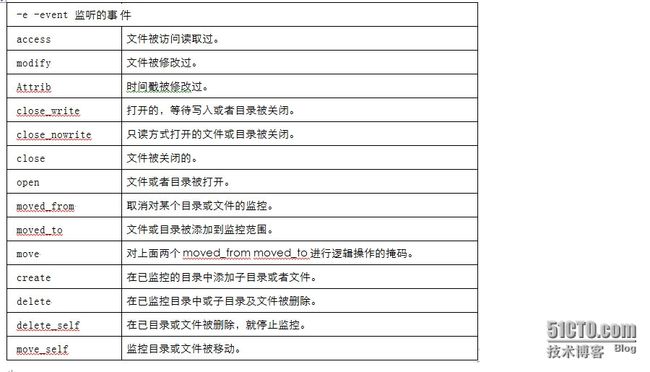一.rsync客户端与服务端结构图:
日常维护中,数据备份算是比较基本的一个了,rsync很好的解决了繁琐的数据时时同步,不需要手动指定变化的数据,而是由rsync自动检测,发现数据不一致时,就开始备份或者推送到其他rsync主机上。inotify是linux监控文件变化的监控工具,可以配合rsync更好的完成工作。很多公司操作系统可能都是不统一的,上面就又添加的一个windows的主机,已实现将在windows主机上将linux主机中的数据拉取到win主机上。
二.rsync简介。
1.)rsync简介,rsync是一个数据同步工具,可以根据数据的变化时时同步,和cp命令及scp命令使用相差不多,命令选项方面也几乎一致。
2.)rsync的特点:可以镜像保存整个目录树或文件系统,传输速率可观,支持ssh实现安全数据传输,支持匿名传输。
3.)rsync工作模式:
shell模式,和cp命令相似,也称为本地文件传输模式。
远程shell模式,和scp命令相似,可以利用ssh协议承载远程传输过程。
列表模式,列表方式出数据源中的内容,也可以远程使用。
服务模式,此时rsync是一个守护进程,能接收客户端数据同步。
4.)rsync命令选项:
5.)rsync几种模式使用。rsync默认就是安装好的。
rsync远端shell模式,本地传输数据到远端。
# rsync -r --stats -e ssh --progress /etc/pam.d [email protected]:/backup/data # ls pam.d #注意/pam.d 和/pam.d/ 传输时候的差距。 # rsync -r --stats -e ssh --progress /etc/pam.d/[email protected]:/backup/data # ls atd cvs newrole polkit-1 runuser sshd su-l chfn eject other poweroff runuser-l ssh-keycat system-auth-ac chsh fingerprint-auth-ac pam.d reboot setup su system-config-network config-util halt passwd remote smartcard-auth-ac sudo system-config-network-cmd crond login password-auth-ac run_init smtp.postfix sudo-i
6.)远端接收数据到本地。
# rsync -a --stats --progress [email protected]:/etc /tmp # ls /tmp/ etc
7.)rsync列表模式。
# rsync -nv [email protected]:/tmp/ [email protected]'s password: receiving file list ... done drwxrwxrwt 4096 2014/08/22 03:40:01 . -rw-r--r-- 813976 2014/08/12 17:59:44apr-1.5.0.tar.bz2 -rw-r--r-- 695303 2014/08/12 17:59:44 apr-util-1.5.3.tar.bz2 -rw-r--r-- 4780289 2014/08/12 17:59:44 httpd-2.4.4.tar.bz2 -rw-r--r-- 4724343 2012/06/29 19:27:06 phpMyAdmin-3.5.1-all-languages.tar.bz2 -rw-r--r-- 4657514 2012/03/12 16:58:14 wordpress-3.3.1-zh_CN.zip -rw------- 0 2014/08/12 17:05:23 yum.log drwxrwxrwt 4096 2014/08/21 21:44:13 .ICE-unix drwxr-xr-x 4096 2014/08/12 18:08:03 apr-1.5.0 drwxr-xr-x 4096 2014/08/12 18:10:18 apr-util-1.5.3 drwxr-xr-x 4096 2014/08/12 18:17:58 httpd-2.4.4 drwxr-xr-x 4096 2014/08/12 23:53:21 phpMyAdmin-3.5.1-all-languages sent 11 bytes received 369 bytes 152.00bytes/sec total size is 15671425 speedup is 41240.59 (DRY RUN)
8.)rsync服务模式。
8.1)安装超级守护进程,并开启rsync服务。
# yum -y install xinetd #安装超级守护进程。
# vim /etc/xinetd.d/rsync
# default: off
# description: The rsync server is a good additionto an ftp server, as it \
# allows crc checksumming etc.
service rsync
{
disable = no #启用rsync
flags = IPv6
socket_type = stream
wait = no
user = root
server = /usr/bin/rsync
server_args = --daemon
log_on_failure += USERID
}
# chkconfig rsync on #开机启动
8.2)编辑rsync配置文件,默认是没有的。
# vim /etc/rsyncd.conf # Global Settings uid = nobody #运行进程的用户。 gid = nobody #运行进程的组。 use chroot = no #运行rsync时不可以使用chroot。 max connections = 10 #最多允许多少客户端同时请求数据。 strict modes = yes #启用严格模式。 pid file = /var/run/rsyncd.pid #rsync的pid文件位置。 log file = /var/log/rsyncd.log #rsync日志位置。 # Directory to be synced [tools] #类似于共享名。 path = /backup/data #数据同步目录。 ignore errors = yes #传输时忽略错误信息。 read only = no #是否只读。 write only = no #是否为只写。 hosts allow = 172.16.0.0/16 #允许同步的网段。 hosts deny = * #由上面过滤下来,超出172.16.0.0网段的都不允许同步。 list = false #是否允许远端列出目录下的文件。 uid = root #共享使用哪个用户身份运行。 gid = root #共享使用哪个组身份运行。
8.3)重启xinetd,查看rsync监听端口。
# /etc/init.d/xinetd start #启动超级守护进程。 Starting xinetd: [ OK ] # ss –tnl #rsync监听在873端口 State Recv-Q Send-Q Local Address:Port PeerAddress:Port LISTEN 0 64 :::873
9)客户主机向rsync服务主机推送数据。
切换到172.16.32.10主机
# rsync /etc/fstab 172.16.32.11::tools
10.)在回到rsync主机看看/backup/data下的数据。
# ls /backup/data/ #rsync服务端主机查看 fstab
11.)另外一种方法,基于rsync协议的推送。
# rsync -a /etc/pam.d rsync://172.16.32.11/tools # ls /backup/data/ #rsync服务端主机查看 pam.d
12.)远端主机向rsync主机拉取数据。
# rsync -a 172.16.32.11::tools/ /tmp # ls /tmp/ #rsync服务端主机操作 pam.d
三.rsync + inotify 实现数据时时同步。
1.)infotify简介:
inotify在Linux内核2.6.13上已经被添加到内核中,是一个可以跟踪文件数据变化的监控工具,结合rsync,对发生变化的数据时时推进同步。
2.)查看内核版本,以及infotify文件位置。
# uname -r 2.6.32-431.el6.x86_64 # ls -l /proc/sys/fs/inotify/ total 0 -rw-r--r-- 1 root root 0 Aug 20 17:26max_queued_events -rw-r--r-- 1 root root 0 Aug 20 17:26max_user_instances -rw-r--r-- 1 root root 0 Aug 20 17:26max_user_watches
3.)客户端安装inotify-tools,实现两个主机目录数据同步。
# rpm -ql inotify-tools /usr/bin/inotifywait #监控文件变化命令。 /usr/bin/inotifywatch #监控时间变化,访问次数等。 …
4.)inotify命令选项。
5.)添加inotify时时监控脚本,实现数据时时同步。
# vim /usr/local/bin/inotify.sh #!/bin/bash /usr/bin/inotifywait -mrq --timefmt '%d/%m/%y%H:%M' --format '%T %w%f' -e modify,delete,create,attrib /data/ | while readfile do /usr/bin/rsync -vzrtopg --delete --progress /data/ [email protected]::tools echo "${files} was rsynced" >>/var/log/rsync.log 2>&1 done
6.)客户端添加一个数据,测试是否rsync+inotify客户端和rsync服务端数据是否同步。
使用bash –x 可以看到脚本的执行过程。
# bash -x /usr/local/bin/inotify.sh + read file + /usr/bin/inotifywait -mrq --timefmt '%d/%m/%y%H:%M' --format '%T %w%f' -e modify,delete,create,attrib /data/ #当我在客户端创建一个nihao的时候 sending incremental file list ./ nihao/ #这里会显示出来新创建的数据 sent 68 bytes received 16 bytes 168.00bytes/sec total size is 0 speedup is 0.00 + echo ' was rsynced' + read file
7.)再去rsync服务端查看下是否同步。
# ls /backup/data/ nihao
可以定义cron任务计划,每分钟执行一次。
*/1 * * * */bin/sh /usr/local/bin/inotify.sh & &>/dev/null
四.在windows rsync客户端主机上拉取linux数据实现同步。
window操作系统为WindwosServer 2008 R2。
1.)提前安装好rsync软件,window版本。
2.)使用2008系统的PowerShell查看rsync的端口号。检查是否启动。
3.)开始拉取linux主机上的数据。
数据可以同步了。
总结:即使在rsync服务器端删除了数据也没关系,在下一次执行脚本的时候,会把缺失的数据一起补回去。这里没有使用rsync用户验证,一般服务器都是有两块网卡,同步数据的时候都是使用内网网卡,外网卡需要支撑线上业务。既然使用内网网卡,rsync主机端也定义了合法网段才给同步数据,所以就不做用户认证了。






